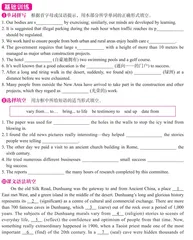Unit 3 The world meets China

Section Ⅰ Starting out & Understanding ideas
单词拼写 根据首字母或汉语提示,用本部分所学单词的正确形式填空。
1.Our bodies are s by exercising; similarly, our minds are developed by learning.
2.It is suggested that illegal parking during the rush hour when traffic reaches its p should be regulated.
3.We work hard to ensure people from both urban and rural areas enjoy health care c .
4.The government requires that large s with a height of more than 10 meters be managed as major urban construction projects.
5.The hotel (自豪地拥有) two swimming pools and a golf course.
6. It’s well known that a good education is the (通向……的门户) to success.
7.After a long and tiring walk in the desert, suddenly, we found a(n) (绿洲) at a distance before we were exhausted.
8.Many people from outside the New Area have arrived to take part in the construction and other projects, which they regard as (光荣的) work.
选择填空 用方框中所给短语的适当形式填空。
vary from… to… bring... to life be testimony to seal up date from
1.The paper was used for the holes in the walls to stop the icy wind from blowing in.
2.I found the old news pictures really interesting—they helped the stories people were telling .
3.The other day we paid a visit to an ancient church building in Rome, the sixth century.
4.He tried numerous different businesses small success big success.
5.The reports the many hours of research completed by this committee.
课文语法填空
On the old Silk Road, Dunhuang was the gateway to and from Ancient China, a place 1 East met West, and a green island in the middle of the desert. Dunhuang’s long and glorious history represents its 2 (significant) as a centre of cultural and commercial exchange. There are more than 700 famous caves in Dunhuang, which 3 (carve) out of the rock over a period of 1,000 years. The subjects of the Dunhuang murals vary from 4 (religion) stories to scenes of everyday life, 5 (reflect) the confidence and optimism of people from that time. Now, something really extraordinary happened in 1900, when a Taoist priest made one of the most important 6 (find) of the 20th century. In a 7 (seal) cave were hidden thousands of manuscripts, paintings and scrolls, as well as silk embroideries. The scrolls are 8 detailed that they describe the vast range of goods that were imported and exported from Dunhuang. In the Ming Dynasty, trade routes changed and Dunhuang was not as prosperous as it used to be. Gradually, it faded 9 memory, even though it was once such a great city. Dunhuang has once again become a global crossroads since it 10 (host) hundreds of representatives from 51 countries for the Silk Road International Cultural Expo in 2017.
1. 2. 3. 4. 5.
6. 7. 8. 9. 10.
阅读理解
The Chinese art of paper cutting has a long history. The earliest paper cutting was found in China in the Northern Dynasties. The United Nations Educational, Scientific and Cultural Organization has added the art, called jianzhi, to its Intangible Cultural Heritage. But jianzhi is at risk of disappearing. Voyo Woo, a Chinese immigrant to the US, hopes to bring the art back to life.
Ms Woo loves paper cutting. And she works hard to celebrate the ancient art form. On a recent Saturday, Ms Woo held a paper cutting show at a shopping center near Washington. She demonstrated the art to crowds for hours at the center.
Ms Woo began to study the art of paper cutting as a 14-year-old girl in her hometown in southeastern China. She said all the students at school had to learn the art. But she developed a special love for it, so her teacher gave her extra training after class. Later, she won second prize in a national painting and handwriting competition. Ms Woo came to the US after she finished college in 2008. Soon after, she became involved in an event to support and expand understanding of Chinese paper cutting. She has been invited to demonstrate the art at a wide collection of events. She has also shown her skill at famous museums like the Smithsonian Institution’s Freer and Sackler art galleries in Washington. Ms Woo says paper cutting represents Chinese cultural values, history and stories of people’s lives. She uses the art as a tool to present Chinese culture to people who know little about it.
Ms Woo placed examples of her art around her as she demonstrated paper cutting at the shopping center. Some shoppers, like Ann Russ, took part in a workshop. Ms Russ was struck by the finely detailed nature of the work. Ms Woo says Chinese art is for all people. “It is amazing how Chinese art can echo with people from other cultural backgrounds.”
1. What can we learn about jianzhi from Paragraph 1?
A. It is popular now in the US. B. It is a world cultural heritage.
C. It has come back to life. D. It dates from the Qing Dynasty.
2. Why did Ms Woo hold a paper cutting show at a shopping center?
A. To meet the need of her business. B. To do her job for the United Nations.